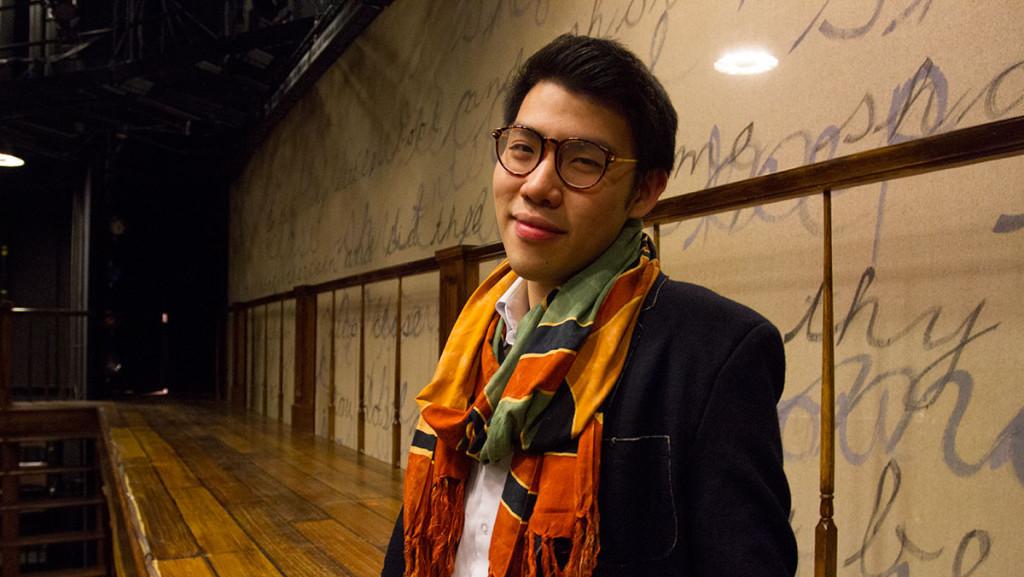Senior Ravi Rakkulchon sits comfortably on a sofa placed on the stage in the Clark Theatre. The set of Ithaca College’s spring opera production “Little Women” surrounds him. A piano stands in one corner, and behind him are windows flanked by two wooden staircases. For Rakkulchon, this is no ordinary set — this is a world created through his imagination.
A native of Bangkok, Thailand, Rakkulchon left home in 2011 to major in theater production arts with a concentration in design at the college. Rakkulchon said he was drawn to the college by the sense of family he felt in the theater department.
“Every other school has their own reputation … but there’s a sense of comfort I feel that Ithaca College has that other colleges didn’t provide me during the interview,” he said.
Involved in theater in high school as an actor, Rakkulchon said he discovered technical theater his junior year, working as an associate on sets and costumes for a teacher’s play.
“I realized there’s a backstage side to the world other than just actors, and I fell in love with that,” he said.
Rakkulchon was in charge of scenic design for “Little Women.” The role of a scenic designer is to create drafts of the set for the play as well as the paint elevations, which are scale-model drawings of the details and intricacies of the set. These drafts were then given to the technical designers and scenic painters, who built and painted the sets designed by Rakkulchon.
Senior George Horrocks, technical director of “Little Women,” was given the drafts drawn up by Rakkulchon to make into a physical set, a process he said requires a good deal of communication. Horrocks said he enjoyed working with Rakkulchon on this task.
“He was really accommodating in the process, which is something you don’t always get with scenic designers,” he said.
Rakkulchon said he begins his creative process by jumping right into and familiarizing himself with the text.
“Read the play. And then read the play again,” he said. “You should read the play roughly about 10 times.”
While reading, Rakkulchon began researching, sketching and listening to the music. Rakkulchon said it was a six-week process to develop a mock-up for the set, going through four versions before deciding on a final draft. He said he worked 6–8 hours a day, including weekends, to bring his idea to life. Rakkulchon said he found listening to the music to be a key part of the creative process.
“I feel we need to serve the music as much as we do the story itself,” he said.
However, Rakkulchon has a close connection with the story — “Little Women” was the first book he ever read in English. Paired with the sentimentality, Rakkulchon said designing the set was a balance between history and the artistic execution of the opera.
“New England at that time was very dark, but the direction we wanted to go — because of the music, how it’s written — the story was very light in terms of color,” he said. “I had to find a halfway point between historical and emotional.”
For the set of “Little Women,” Rakkulchon said he took inspiration from paintings, as well as from the Orchard House in Concord, Massachusetts, where Louisa May Alcott wrote her book.
Senior Samantha Salloway was the stage manager for “Little Women,” and said she was impressed with the ideas and research done by Rakkulchon. Salloway said Rakkulchon was deeply invested in his work being presented onstage, a quality she said she appreciated.
“The set he designed was beautiful,” she said. “It’s so nice to work with someone who cares so much about what they do.”
After spending four years abroad, Rakkulchon found that the most striking theatrical difference between Thailand and the United States is the development of the craft in each respective nation.
“Theater here is much more advanced,” he said. “At home, theater is still considered an art form which is not as popular, whereas in America it is much more open.”
Looking toward the future, Rakkulchon said he hopes to eventually go back home and develop the theater scene in Thailand.
“Theater has been serving a niche market back home,” Rakkulchon said. “It’s not very popular. Theater globally can spark up a lot of conversation.”
Rakkulchon said he hopes to make theater a bigger part of life in his home country by gaining professional experience in the United States that he can bring back with him.
“Being here in the theater arts department here is step one,” he said.
Until then, Rakkulchon can be found in his studio in Dillingham working to communicate the ideas of plays to audiences, a task that drives his passion for the art form. For Rakkulchon, theater is not just entertainment. He said it shows audience members and performers the realities of human nature.
“Theater to me is the truth,” he said. “It shows more truth than reality itself.”














